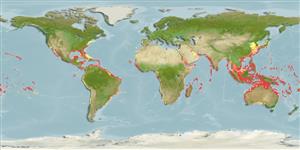>
Carangaria/misc (Various families in series Carangaria) >
Sphyraenidae (Barracudas)
Etymology: Sphyraena: Greek, sphyraina, -es = the name of a fish (Ref. 45335).
Environment: milieu / climate zone / depth range / distribution range
Ecologia
marino; salmastro associati a barriera corallina; distribuzione batimetrica 0 - 100 m (Ref. 6949), usually 3 - 30 m (Ref. 40849). Subtropical; 42°N - 35°S, 180°W - 180°E (Ref. 55300)
Indo-Pacific: Red Sea and east coast of Africa to Hawaii and the Marquesas and Tuamoto islands. Western Atlantic: Massachusetts (USA), Bermuda, and throughout the Caribbean Sea to Brazil (Ref. 9626). Eastern Atlantic: Sierra Leone, Côte d'Ivoire, Togo, Nigeria, Senegal (Ref. 6949), Mauritania (Ref. 5377), St. Paul's Rocks (Ref. 13121), and São Tomé Island (Ref. 34088).
Length at first maturity / Size / Peso / Age
Maturity: Lm 66.0, range 58 - 98.5 cm
Max length : 200 cm TL maschio/sesso non determinato; (Ref. 7251); common length : 140 cm TL maschio/sesso non determinato; (Ref. 3692); peso massimo pubblicato: 50.0 kg (Ref. 6949); Età massima riportata: 18 anni (Ref. 128046)
Spine dorsali (totale) : 6; Raggi dorsali molli (totale) : 9; Spine anali: 2; Raggi anali molli: 8. This species is distinguished by the following characters: a large body, large eyes; body depth 6.0-8.2 in SL; teeth erect and contiguous; no gill rakers on first gill arch, instead upper and lower gill arch with rough platelets which lack distinct spines; origin of first dorsal fin at level of the rear base of the pelvic fins; caudal fin emarginate with a pair of large lobes at posterior margin, except young less than 50 cm TL which have a forked caudal fin. Colour of body silvery; many oblique dark bars on upper half of body that do not across lateral line; caudal fin black with white tips; juveniles with a series of large dark blotches irregularly arranged on sides of body (Ref. 9768, 90102).
Found predominantly at or near the surface (Ref. 6949, 48637). Juvenile occurs among mangroves, estuaries and shallow sheltered inner reef areas; adult occurs in a wide range of habitats from murky inner harbors to open seas. Diurnal and solitary, but can also be found in small aggregations. Feeds on fishes, cephalopods and sometimes on shrimps (Ref. 9626, 48637). Sold fresh. Utilized also dried or salted (Ref. 9987). Although this species is ciguatoxic elsewhere throughout its range, it has not been reported to be poisonous in the eastern Atlantic (Ref. 6949, 48637). Rarely attacks humans, usually with one quick, fierce strike, which, although serious, is rarely fatal. The world's record on hook and line is a 5.5-ft. fish taken in the Bahamas that weighed 103 lbs. (Ref. 13442). Caught by handline, set nets, and other fishing gear (Ref. 9768). Minimum depth reported taken from Ref. 128797.
Daget, J., 1986. Sphyraenidae. p. 350-351. In J. Daget, J.-P. Gosse and D.F.E. Thys van den Audenaerde (eds.) Check-list of the freshwater fishes of Africa (CLOFFA). ISNB, Brussels; MRAC, Tervuren; and ORSTOM, Paris. Vol. 2. (Ref. 4339)
IUCN Red List Status (Ref. 130435: Version 2024-1)
Threat to humans
Traumatogenic (Ref. 4690)
Human uses
Pesca: scarso interesse commerciale; Pesce da pesca sportiva: si; Acquario: Acquari pubblici
Strumenti
Special reports
Download XML
Fonti Internet
Estimates based on models
Preferred temperature (Ref.
123201): 21.7 - 28.9, mean 27.2 °C (based on 2020 cells).
Phylogenetic diversity index (Ref.
82804): PD
50 = 0.5000 [Uniqueness, from 0.5 = low to 2.0 = high].
Bayesian length-weight: a=0.00851 (0.00708 - 0.01024), b=2.93 (2.89 - 2.97), in cm total length, based on LWR estimates for this species (Ref.
93245).
Trophic level (Ref.
69278): 4.5 ±0.6 se; based on diet studies.
Resilienza (Ref.
120179): Basso, tempo minimo di raddoppiamento della popolazione 4.5 - 14 anni (K=0.09-0.11; tm=2-4).
Prior r = 0.31, 95% CL = 0.20 - 0.46, Based on 2 data-limited stock assessments.
Fishing Vulnerability (Ref.
59153): Very high vulnerability (79 of 100).
Climate Vulnerability (Ref.
125649): Moderate to high vulnerability (52 of 100).
Nutrients (Ref.
124155): Calcium = 5.57 [2.60, 15.19] mg/100g; Iron = 0.229 [0.101, 0.480] mg/100g; Protein = 21.2 [19.3, 22.9] %; Omega3 = 0.124 [0.054, 0.274] g/100g; Selenium = 21.4 [8.5, 52.9] μg/100g; VitaminA = 18.1 [4.1, 117.9] μg/100g; Zinc = 0.298 [0.187, 0.511] mg/100g (wet weight);
